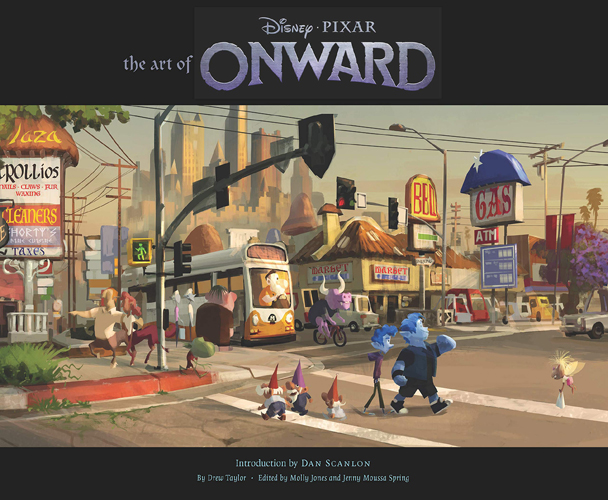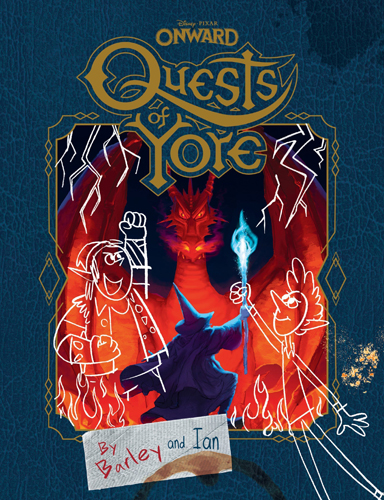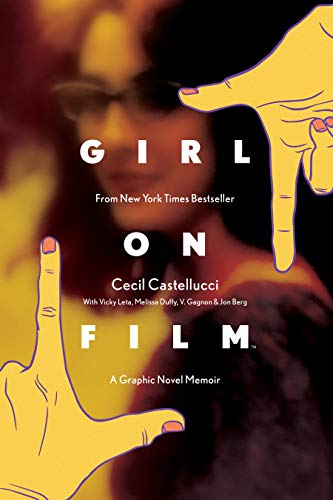Now that school is out, my kids and I have gotten caught up on a few movies that we missed from last summer and this spring, which also meant that I could finally peek into some of these art books. I always try to avoid reading them until after I’ve seen the movie because some books avoid spoilers better than others. So, today’s stack is books about movies: grab some popcorn and dim the lights, because the show’s about to begin!
The Art of Toy Story 4 from Chronicle Books
I really love the Toy Story series. I’ve always been fascinated by animation of all sorts, and I still remember being awed by the original movie, the first fully computer-animated feature film. It made Pixar a household name, and the technology has continued to improve, but the characters of Woody and Buzz and the rest of the toys will always be some of my favorites in the Pixarverse. I missed seeing Toy Story 4 in the theaters (the first of the series I’ve missed) because we had just traveled to Taiwan when it opened, and then it was out of most theaters by the time things settled down after our return. I finally got to see it this past week, and then immediately tore the shrink wrap off The Art of Toy Story 4, which has been patiently waiting for me to be ready, not unlike a toy sitting on a shelf waiting to be played with.
The film itself has, like Toy Story 3, a lot of themes about moving on, about the way that our roles shift and change, and our ability to adapt to those changes. There’s still a lot of the expected humor and fun, but it also has some poignancy that will tug at your heartstrings.
First up: the book does a pretty good job of showing a ton of concept art like character designs and set designs without giving away too much of the story. Spoilers for some things are unavoidable (like the fact that the movie centers around Forky, a “toy” that Bonnie made from a spork), but I think the book gives away perhaps even less of the story’s surprises than the movie trailer did. Of course, I always recommend watching the movie before looking at the “art of” books, but in this case I think it’s safe to read without having the key plot points spoiled. It also helps in that regard that the book includes some storyboards and designs for scenes that were ultimately cut from the film, so you may not be able to piece everything together easily.
As far as what is included in the book: you get a peek at character designs for all of the new characters in the film, both human and toy. There’s not so much of the recurring characters except in cases where there were significant redesigns, but that’s fine: they didn’t really change Buzz and Woody, for instance. You also get a look at a lot of the locations, seeing the evolution of the antique shop, the layout of the carnival, and so on. There are plenty of storyboard sequences, too, showing hand-drawn sketches of scenes that you’ll recognize from the movie. And, of course, there are a lot of beautiful digital paintings that helped to inform the look of the film, whether for the lighting for a scene, or to convey the mood of an interaction, and so on.
The book does feel a little short on text in some places, and in general I like to have better descriptions of the images, rather than just an artist name and the medium. I’ll note that the book doesn’t list an author like some art books do: it credits Annie Potts (the voice of Bo Peep) for the foreword and director Josh Cooley for the introduction. Each blurb scattered throughout the book is credited to a specific Pixar employee—story supervisor, director, production designer, and so on. That may explain why the text doesn’t go more in-depth into the making of the movie. Still, it’s a treasure trove of images that fans of the movie will enjoy. I especially liked seeing things that didn’t ultimately make it into the film, because it shows a bit of the moviemaking process, and the way that the story evolved.
The Art of the Missing Link by Ramin Zahed from Insight Editions
The Missing Link is another animated film that I missed last summer, from one of my favorite studios: LAIKA, known for their gorgeous stop-motion animation. I’ve always loved stop-motion animation (and have tried my hand it myself). I love the way that LAIKA combines traditional animation techniques with modern technology like 3D printing and computer graphics to create films that retain that hand-crafted feel while also allowing for some dazzling special effects and vast landscapes.
The movie features Sir Lionel Frost, a cryptozoologist who has been seeking evidence of mythical creatures in the hopes of finally securing a place in the Optimates Club. Upon receiving a letter offering proof of a Bigfoot, he travels to Oregon, where he meets the Sasquatch himself—and then the two of them have some exciting adventures together.
This art book is organized like the film itself, following the characters’ journey from London to the Pacific Northwest and then back across the Atlantic, in search of the Himalayas. Within each section, we get to see sketches and paintings that eventually became the various characters, costumes, and settings of the movie. Because the book follows the plot of the movie, it does give away most of the story, though the very ending is only hinted at. It’s enough that I would strongly suggest not reading the book until you’ve seen the film if you want to avoid spoilers.
This book does have a lot more text in it, including quotes from the various artists, animators, costume designers, and others involved in the creation of The Missing Link, as well as Zahed’s own text that explains a little more what the filmmakers were trying to do with certain colors or shapes or poses. It’s cool to get that extra glimpse behind the scenes.
Since The Missing Link uses actual, physical puppets and sets, I do wish there were a bit more photos of those physical elements. There are some, for sure, but it felt to me like the focus was more on the concept art, and not necessarily on things like how the costumes were made, or what goes into the creation of the puppets themselves. Having been to LAIKA for a tour of the studio, I know that there’s an incredible amount of work that goes into translating these concepts into reality, and I wish some more of that was showcased in the book. What is included, though, is quite stunning.
The Art of Onward by Drew Taylor, edited by Molly Jones and Jenny Moussa Spring
Onward is Pixar’s latest film, and was released right around the time that lockdowns began, so it didn’t have as much time in theaters. The story is set in a fantasy world that has become modernized: it still has elves and centaurs and goblins, but technology has pretty much replaced magic. Within this world, we meet Ian Lightfoot, newly turned 16, along with his older brother Barley and his mom. Ian’s father died before he was born, but left behind a spell to bring him back to life for one day. Unfortunately (as you may know from the movie trailer), something goes wrong, and Ian and Barley are only able to bring back dad’s bottom half. The rest of the movie is their quest to find another magical phoenix gem to complete the spell.
One of the things I liked about The Art of Onward is that it digs a little more into how the story developed. It was inspired by director Dan Scanlon’s own life: his father died when he was one and his brother was three, so they never really got to know them, and Scanlon always wondered whether he had any similarities to his father. So Ian and Barley’s journey is based on a very personal story, but then the rest of the Pixar crew also brought in their own experiences to the story. The book starts off with a colorful chart indicating the 8 different screenings held internally at Pixar during the movie’s development, showing how various things changed: who the primary characters were, Ian’s motivation to meet his dad, the objective of the quest, and more. Throughout the book, many images are marked with a color-coded number, so you can match that particular image to the version of the story where it fit.
This book has a lot of text: each section has a written introduction by Drew Taylor, which includes interviews with the filmmakers, but there are also brief quotes paired up with many of the images to serve as captions. I like seeing the character designs, especially where there are lots of written notes and adjustments made to a drawing, because you can see how much attention is put into even small details. There’s a lot included about the world-building: what would buildings look like? What would signs look like? Which fantasy creatures would populate their world? One of the funny details is that Scanlon himself apparently knew very little about fantasy as a whole, so all of the fantastical elements in the movie were things that other people had to teach him about.
Since the book goes into a lot of detail about the story’s evolution, it spoils a lot of the plot and there’s not much that isn’t shown, including the movie’s ending. That means you do get to see more of everything in this book, but it’s totally a spoiler and should be saved for after the viewing. But it does also make for some great reading after watching the movie, because of the way it also shows things that didn’t ultimately make the cut, like the minotaur’s labyrinth that became a shopping mall. It’s definitely a nice companion book for the movie.
Onward: Quests of Yore by Ian and Barley from Disney Press
In the film Onward, Barley plays a role-playing game called Quests of Yore that features heavily in the film. It’s a fantasy game, but (as Barley explains) it is all based on history, a time when magic was still prevalent in the world. In particular, Barley refers to the game’s manual quite often throughout the movie, using it to explain the customs of questing to Ian, who was never really interested in the game. The magic spells that Ian learns in the movie are also pulled straight from the book (since they were based on actual spells).
Quests of Yore is a reproduction of that hardcover RPG manual and you’ll recognize many of its pages right out of the film. But it’s also made to look like Barley’s copy of the book, with a lot of additional notes and taped-in materials from Ian and Barley, as if they were added during the course of their quest: sticky notes with doodles, photos duct-taped into the book, and even sheets of notebook paper that obscure entire pages of the book but allow Ian and Barley to tell their own tale of questing.
It’s a lot of fun to flip through, and I like the way it looks like an actual artifact from the movie. (I know that there’s an actual Quests of Yore game coming this fall, and I’ll be curious to see if they’re able to use the same manual but without the ephemera.) While I wasn’t particularly interested in the kids’ novelization of the movie, this tie-in book is really well done and I enjoyed it. Note: Because the book includes the various notes and comments from Ian and Barley during their quest, this book is full of spoilers for the movie itself.
Spoiler Alert! The Badass Book of Movie Plots by Steven Espinoza, Kathleen Killian Fernandez, and Chris Vander Kaay
Normally I always avoid spoiler alerts (as you can tell from today’s column), but here’s a book of spoiler alerts that you’ll definitely want to read. The creators of the book have taken 38 different film genres, from Inspirational Teacher Drama to Buddy Action Comedy to Political Conspiracy Thriller, and broken each one down into a six-page, trope-laden summary. Each one includes a movie poster (often with taglines and actor names), suggestions for naming your movie (Romantic Comedy? “Various combinations of a number, an instructional word, and a romantic object”), a cast of characters and elements and settings, and a few lines of essential dialogue. The plot itself is broken down into three acts outlining the plot in 6-panel comics, hitting all the major beats (and cliches) of that film genre.
From Alien Invasion to Zombie, this book has it all. As they explain in the introduction, it’s a book that will have film buffs laughing along at all the references to movies they’ve seen, and will peel back the curtain for casual moviegoers to see some of the common tropes used in films. I had a lot of fun reading through these with my kids—each genre can serve as a nice short read-aloud story, too!
Girl on Film written by Cecil Castellucci, illustrated by Vicky Leta, Melissa Duffy, V. Gagnon, Jon Berg
Cecil Castellucci was going to make movies. After falling in love with Star Wars and Raiders of the Lost Ark in theaters, she was sure that was her destiny. She eventually attended the Performing Arts High School (after seeing it on the TV series Fame), and continued to pursue her dream of becoming a filmmaker. This comic book memoir digs into Castellucci’s journey, intermingled with present-day conversations with her scientist father about memory and how our brains process and remember (or misremember) information. There are some famous faces that show up in surprising places: one of her classmates is Cher’s son and Andy Warhol shows up to his birthday party; Mo Willems is her freshman mentor at NYU; her college friend hangs out with Anthony Michael Hall and Robert Downey Jr.
Castellucci didn’t end up making movies the way she had imagined, though she did end up in Hollywood. Instead, she’s been telling stories in other ways: young adult novels and comic books. This book is an intimate look at a girl chasing her passions, and the convoluted path she took (including some of the difficulties of making an actual film, both technical and economical). It’s also a snapshot of a moment in time, life and arts in New York in the 1980s.
My Current Stack
Other than the books listed above, I’ve just started reading the second book in the World Citizen Comics series: Fault Lines in Our Constitution, which is about how the Constitution was put together, and the way that some of its flaws still affect us today. I also finally located my copy of Iron Gods by Andrew Bannister. I’d read Creation Machine last summer, and had my copy of the third book in the series, but for whatever reason the second book had gotten somewhere entirely different. Now that I’ve found it, I can finally continue reading it to see where the story goes next.
Disclosure: I received review copies of the books in today’s column.










